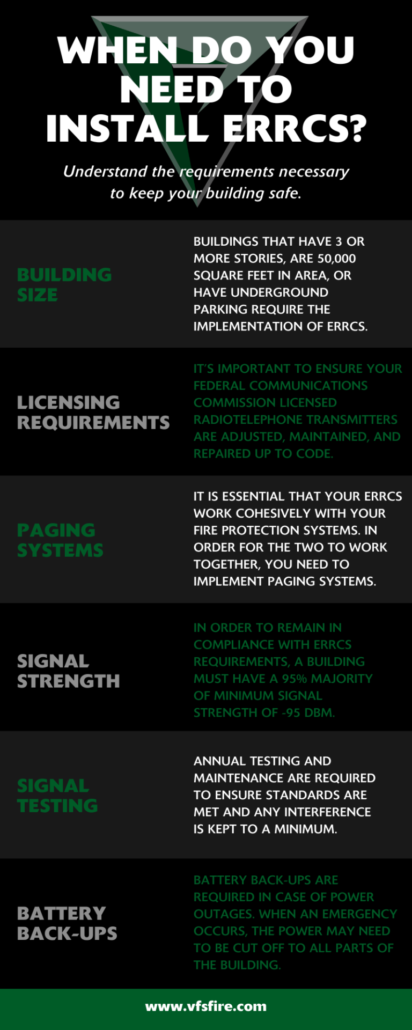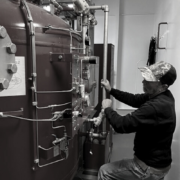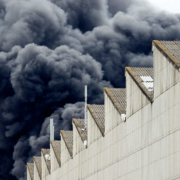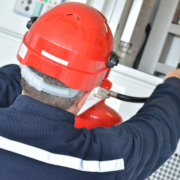5 THINGS CRE OWNERS SHOULD KNOW ABOUT INSTALLING ERRCS
DON’T GET IRKED BY ERRCS
What happens when an emergency occurs in your building? Will people be able to communicate outside the building for help? Will they be guided to safety? Can the occupants dial 911 from their cell phones?
It’s important that first responders are able to communicate with other emergency responders outside of the building. As a building owner, it is your responsibility to manage evacuation, communication, and signal systems.
Buildings are typically composed of materials that inhibit cellular and other communication signals. In order to boost signals within your building and ensure public safety compliance, you can utilize ERRCS systems.
WHAT ARE ERRCS?
An Emergency Responder Radio Communication Systems (ERRCS) is a required standard for most buildings. ERRCS is a building communication system that improves communication within the building to those outside. This extension of the public safety network utilizes small antennas called Distributed Antenna Systems (DAS) that receive and transmit radio signals from the first-responder network.
These ERRCS systems are composed of various components that ensure they are working efficiently and effectively. A Bi-Directional Amplifiers system is integrated to connect the smaller antennas to the donor antenna. This antenna then transmits and receives radio frequencies from the public safety network.
ERRCS IS NOT REQUIRED FOR EVERY COMMERCIAL BUILDING. HOW CAN YOU DETERMINE WHEN YOU NEED TO INSTALL ERRCS?
Start by checking your local jurisdiction to see if there are ordinances in place that relate to public safety communications. The general requirements for all buildings is that public safety radios must work in the building. If public safety radios are tested and work successfully, especially in critical areas like stairwells, electrical rooms, mechanical rooms, and elevators, then you will not be required to install an ERRCS.
It’s important to understand what might block these signals before you hire someone to test your communication capabilities. Exterior walls and glass are just the beginning when it comes to potential signal blockages. Interior walls, office furniture, equipment, and people can also impact signal transmission.
WHEN ARE ERRCS REQUIRED?
There are various requirements for installing ERRCS in your commercial building. Here are a few of the common requirements you need to be aware of.
BUILDING SIZE
Buildings that have 3 or more stories, are 50,000 square feet in area, or have underground parking require the installation of ERRCS. Buildings with complex layouts have a challenging time keeping the signal strength in all areas of the building.
Challenging layouts typically include thick walls and multi-room floors. If your building is made up of metal, concrete, brick, wood, or Low-E glass, the signal may be blocked or disrupted. In order to remain in compliance with IFC regulations, you must ensure the RF signal is amplified in all areas of the building.
LICENSING REQUIREMENTS
It’s important to ensure your Federal Communications Commission licensed radiotelephone transmitters are adjusted, maintained, and repaired up to code. These services require special training, so it’s important that you hire a trusted resource to perform inspection and maintenance on your equipment. Our experts at VFS are trusted to ensure our clients remain in compliance and up to code.
PAGING SYSTEMS
It is essential that your ERRCS work cohesively with your fire protection systems. In order for the two to work together, you need to implement paging systems. Paging systems help announce instructions to building occupants to ensure their safety.
SIGNAL STRENGTH
In order to remain in compliance with ERRCS requirements, a building must have a 95% majority of minimum signal strength of -95 dBm. This level is a standard in emergency responder communication systems. In order to ensure this requirement is met, you may need to boost the signal through DAS or other signal boosters.
SIGNAL TESTING
Annual testing and maintenance are required to ensure standards are met and any interference is kept to a minimum. VFS is licensed and certified to help your building remain in compliance with these testing and maintenance requirements.
BATTERY BACK-UPS
Battery back-ups are required in case of power outages. When an emergency occurs, the power may need to be cut off to all parts of the building. When your back-ups are reliable, you ensure your emergency systems are running when you need them most.
Do you know if your building requires ERRCS to be implemented? If not, our experts can help! Contact our team today to see how we can help your building remain compliant and, more importantly, safe!














